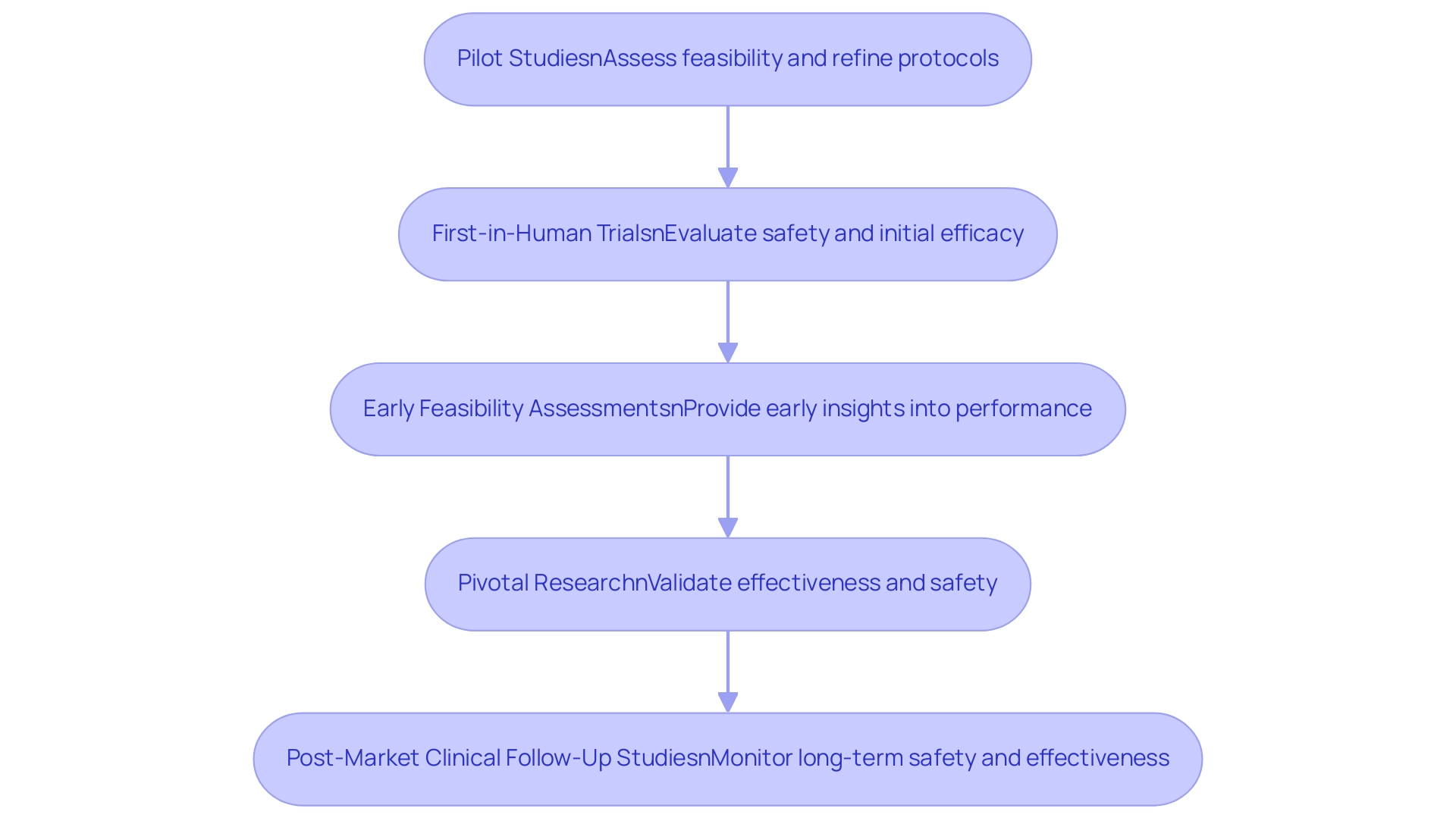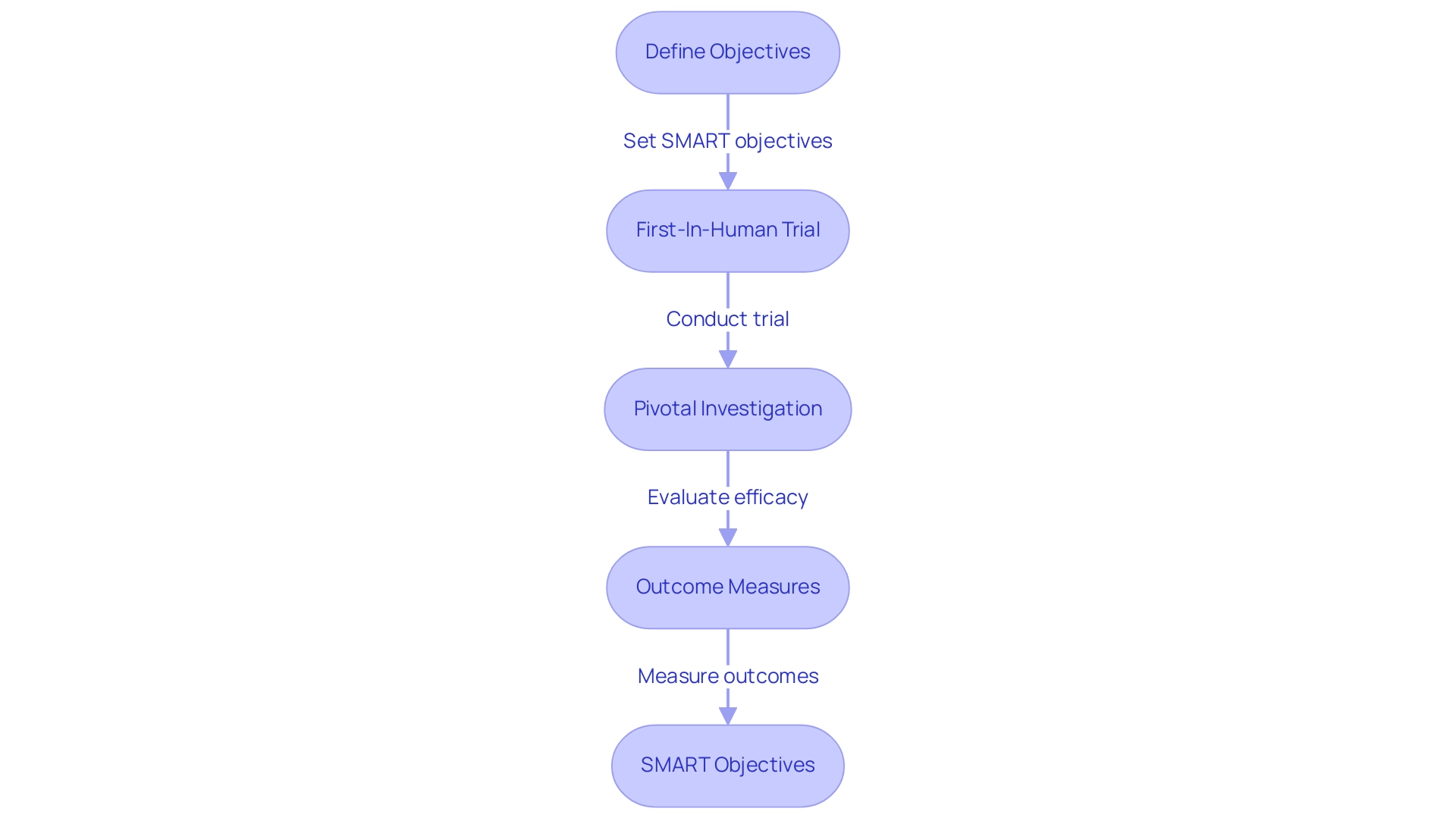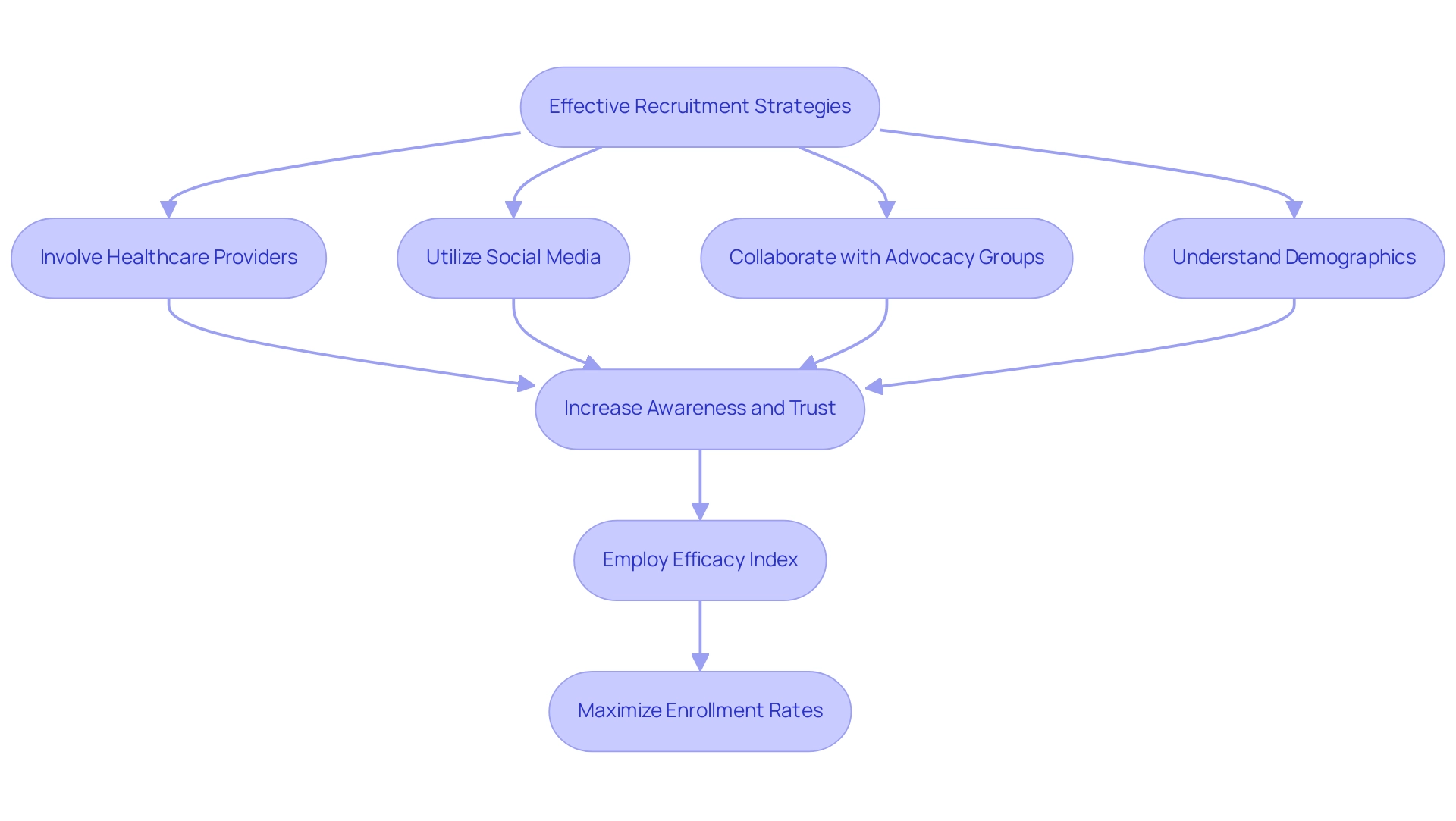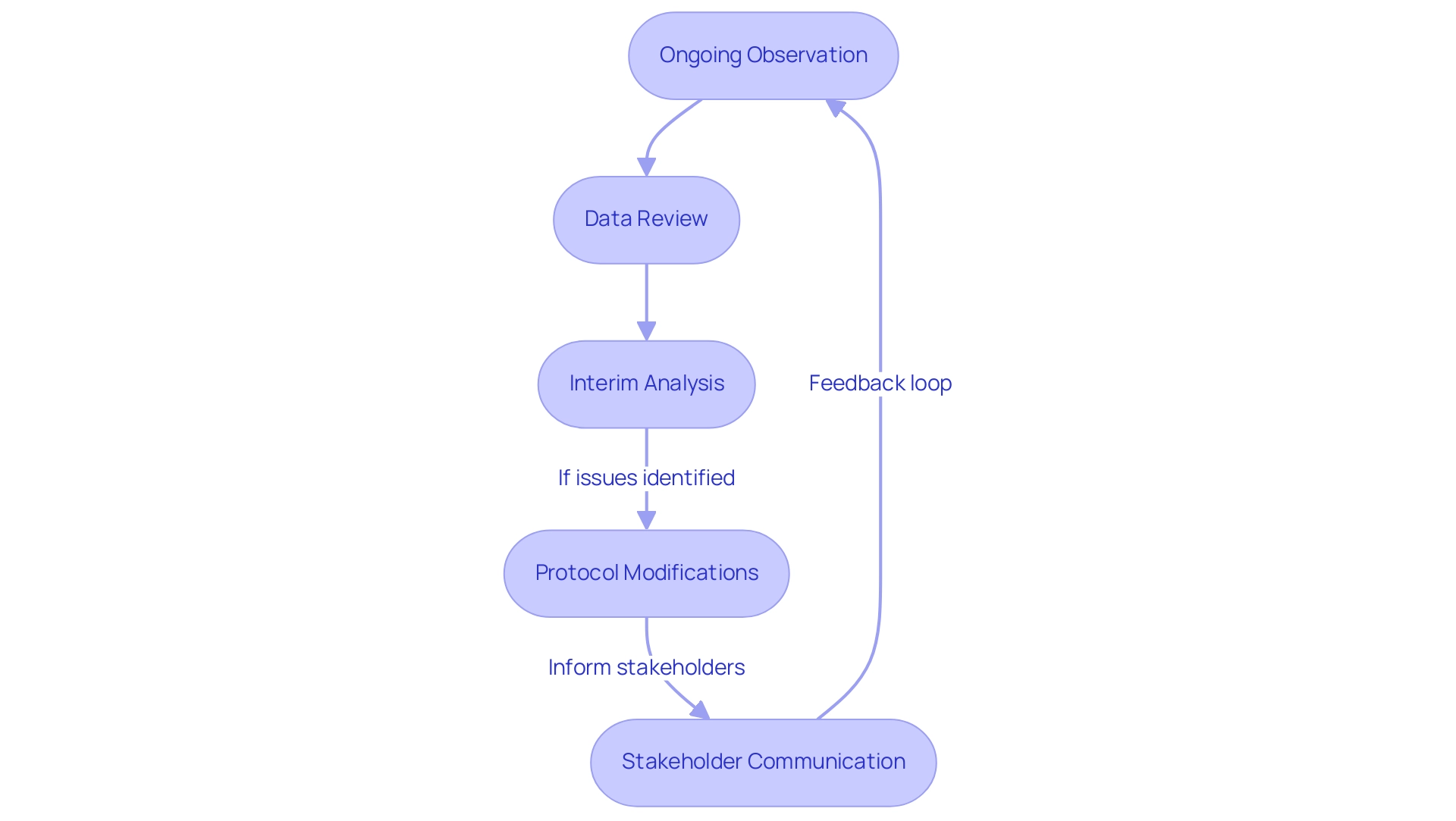Overview
The article focuses on essential strategies for designing multi-phase clinical trials, aimed at enhancing the effectiveness of medical research. It articulates the significance of structured methodologies and clear objectives, alongside appropriate study designs and effective recruitment. Furthermore, data management, continuous monitoring, and stakeholder engagement are underscored as critical components for successfully navigating the complexities of clinical evaluations in the Medtech industry. These strategies not only streamline the research process but also foster collaboration among stakeholders, ultimately leading to improved outcomes in clinical trials.
Introduction
In the realm of clinical research, multi-phase trial designs serve as a critical framework for evaluating medical interventions, ensuring that each phase builds upon the insights of its predecessor. As the Medtech industry faces rapid innovation and stringent regulatory demands, understanding these designs becomes essential for successful outcomes. From pilot studies to post-market follow-ups, each phase is meticulously crafted to address specific objectives, utilizing tailored methodologies that enhance the overall efficiency of clinical trials.
As the landscape continues to evolve, the integration of adaptive designs and robust data management practices is paramount. This empowers researchers to navigate complexities and ultimately deliver life-changing medical technologies to the market. With expert insights and strategic planning, stakeholders can significantly improve trial success rates while fostering trust and collaboration throughout the research process.
Understanding Multi-Phase Trial Designs: An Overview
Multi-phase experimental frameworks represent a structured methodology that encompasses several sequential phases, each tailored to achieve specific objectives and employ distinct methodologies. These patterns are essential in medical research, enabling a structured assessment of healthcare interventions and ensuring that each stage efficiently builds upon the knowledge acquired from the prior one. This approach is particularly critical in the Medtech industry, where the pace of innovation and adherence to regulatory standards are essential for success.
Typically, multi-phase research designs include pilot investigations, first-in-human (FIH) experiments, early feasibility assessments (EFS), pivotal evaluations, and post-market clinical follow-up investigations (PMCF). Each phase plays a unique role in the overall research continuum:
- Pilot Studies: These initial trials assess the feasibility of the intervention and help refine study protocols.
- First-in-Human Trials: Conducted to evaluate the safety and initial efficacy of a medical device in humans, these trials are crucial for gaining regulatory approval. For instance, Avantec Vascular has chosen bioaccess™ to support its first-in-human clinical trial of an innovative vascular device in Latin America, highlighting the importance of expert guidance in this phase.
- Early Feasibility Assessments: These assessments provide early insights into the device's performance and inform further development. Bioaccess® specializes in managing such projects, ensuring that clients receive tailored support throughout the process.
- Pivotal Research: Created to validate the effectiveness and safety of the device, pivotal research is often required for regulatory submissions.
- Post-Market Clinical Follow-Up Studies: These studies monitor the long-term safety and effectiveness of the device once it is on the market.
With more than 20 years of experience in the Medtech sector, bioaccess® possesses the knowledge and tailored strategy required to manage the intricacies of research studies effectively.
Recent statistics emphasize the increasing use of multi-phase approaches, with 3 out of 16 COVID-19 studies (18.8%) employing group sequential methods, demonstrating their importance in swiftly changing clinical environments. Furthermore, the integration of seamless phase II/III studies has emerged as a promising advancement, allowing for real-time adjustments based on early results, thereby expediting the development of effective therapies. A case study titled "Seamless Phase II/III Studies: A New Approach" illustrates this evolution, demonstrating how these frameworks enhance study efficiency by enabling quicker decision-making regarding treatment arms.
Expert opinions emphasize the necessity of these designs in optimizing health outcomes. As expressed by Mohamed Ben-Eltriki, a postdoctoral researcher, "Proper guidance on planning adaptive studies with simulations of possible adaptation scenarios for risk-benefit evaluations, supported with medical input and statistical analysis is necessary to optimize outcomes." This insight highlights the significance of methodological transparency and compliance with reporting guidelines, which are essential for improving comprehension and implementation of adaptive studies.
In summary, multi-phase trial design strategies are not merely procedural frameworks; they serve as strategic tools that enhance the efficiency and effectiveness of medical research in the Medtech sector, ultimately leading to the faster development of life-changing medical devices. With bioaccess®'s expertise in managing early feasibility, first-in-human, and other crucial research, clients can navigate the complexities of clinical evaluations with confidence.

Defining Clear Objectives for Each Phase
Defining clear objectives for each phase of multi-phase trial design strategies is essential for maintaining focus and direction throughout the research process. These objectives must adhere to the SMART criteria—specific, measurable, attainable, relevant, and time-bound. For instance, in a first-in-human trial, the primary objective might concentrate on assessing the safety and tolerability of a new medical device. This process is expertly managed by bioaccess®, leveraging its extensive experience of over 20 years in Medtech and its proficiency in First-In-Human Trials.
Conversely, a pivotal investigation may aim to demonstrate its efficacy compared to existing treatments. Bioaccess® is well-equipped to support this endeavor through its comprehensive management services, which include:
- Feasibility assessments
- Site selection
- Compliance reviews
- Setup
- Import permits
- Project management
- Reporting
The significance of clear objectives in multi-phase trial design strategies cannot be overstated, particularly in 2025, as the research landscape continues to evolve. Research indicates that most trial participants establish objectives across various categories, including physical activity, nutrition, and personal growth. This trend underscores the necessity for researchers to define objectives that resonate with both the project's aims and the participants' motivations.
Case analyses have illustrated that clearly outlined goals can substantially enhance the results of multi-phase trial design strategies in clinical evaluations. For example, the study titled "Crime as an Identity" explored how individuals may adopt behaviors as part of their self-concept, highlighting the importance of clear goal-setting in understanding behavior change. By employing SMART objectives, researchers can create a structured framework that guides each phase of the study, ensuring that all efforts align with the overarching research goals.
Moreover, statistics reveal that trials with clearly defined SMART objectives tend to achieve higher success rates. Outcome measures of research have included:
- The number of recalled learning goals
- Self-reported executed educational actions
- The quality of each learning goal and educational action after a two-week follow-up period
This correlation emphasizes the need for researchers to prioritize objective setting as a foundational element of their study design.
Successful objective setting not only streamlines the research process but also enhances the credibility and reliability of the findings, ultimately contributing to the advancement of medical technology through the implementation of multi-phase trial design strategies. As Victoria Stewart noted, "The researchers were independent from the funder," underscoring the importance of upholding integrity in medical research. With bioaccess®'s expertise in managing Early-Feasibility, Pilot, and Post-Market Clinical Follow-Up Studies in Latin America, researchers can ensure that their objectives are not only clear but also strategically aligned with the goals of their clinical investigations.

Choosing the Right Study Design for Each Phase
Selecting the appropriate research framework for each stage of multi-phase trial design strategies investigation is essential for achieving dependable and accurate outcomes. Each phase may require a unique method; for example, a pilot study frequently uses a single-arm format to gather initial safety data, whereas pivotal studies generally implement randomized controlled experiments to compare the new intervention with established treatments. This strategic choice depends on several elements, including the particular research question, the traits of the target population, and compliance with regulatory standards.
In 2025, the environment of clinical study methodology is changing, with a significant movement towards approaches that emphasize statistical prediction over conventional hypothesis testing. This trend indicates an increasing awareness of the necessity for adaptable formats that can react to new information during the testing process. The net present value (NPV) for a random classifier, calculated as 1 minus disease prevalence, highlights the significance of comprehending the economic implications of research design decisions.
Statistics show that the choice of research design greatly influences outcomes, with successful pilot projects frequently establishing the foundation for pivotal investigations. For example, the area under the ROC curve (AUC) is a critical metric in diagnostic testing, where an AUC of 1 signifies perfect prediction, while an AUC of 0.5 indicates random prediction. This underscores the importance of selecting optimal thresholds that maximize sensitivity while minimizing false positive rates (FPR). The ROC curve analysis case example illustrates how careful selection of these thresholds can enhance the reliability of diagnostic tests.
Expert insights reveal that the Hochberg step-down procedure is increasingly favored for controlling false-discovery rates in functional MRI analysis. This less conservative approach can enhance the robustness of findings, making it particularly relevant in the context of multi-phase trial design strategies, where multiple comparisons are common. As researchers navigate the complexities of multi-phase trial design strategies, grasping the nuances of selection becomes paramount.
Professor Yang Wang highlights that the focus on statistical elements, including sample size, research framework, and selection of statistical techniques, differs to meet the distinct goals and challenges of each stage of evaluations.
At bioaccess®, we utilize over 20 years of experience in overseeing evaluations across Latin America, concentrating on Early-Feasibility Assessments, First-In-Human Assessments, Pilot Assessments, Pivotal Assessments, and Post-Market Follow-Up Assessments. Our adaptability and specialized expertise allow us to manage the distinct challenges of medical studies effectively. By coordinating research frameworks with the distinct aims and obstacles of each phase, investigators can greatly enhance the probability of favorable results.
We invite you to interact with bioaccess® to discover how our extensive research management services can assist your study requirements. In summary, the most common study designs utilized in multi-phase trial design strategies in 2025 include adaptive designs, RCTs, and single-arm studies, each serving distinct purposes across different phases.
Implementing Effective Recruitment Strategies
Implementing effective recruitment strategies is crucial for the success of multi-phase trial design strategies, particularly given Barranquilla's emerging status as a leading destination for clinical research in Latin America. The partnership between bioaccess™ and Caribbean Health Group, revealed on March 29, 2019, and backed by Colombia's Minister of Health, highlights the significance of involving healthcare providers to increase awareness about studies. These providers can serve as trusted sources of information for potential participants, enhancing the credibility of the recruitment process.
Employing social media platforms has become a powerful means to reach varied audiences, enabling researchers to engage with individuals who may not be aware of ongoing research. Collaborating with patient advocacy groups further enhances outreach efforts, ensuring that recruitment messages resonate with the communities they aim to serve.
Understanding the demographics and preferences of the target population is essential for tailoring recruitment efforts. For example, providing clear and concise information about the study's purpose, procedures, and potential benefits can alleviate concerns and encourage participation. Research conducted between December 2003 and February 2006 demonstrated the effectiveness of diverse recruitment strategies, revealing that physician referrals and flyers were the most successful methods, leading to the enrollment of 289 participants in a randomized placebo-controlled trial focused on irritable bowel syndrome (IBS).
The clinic was available for a total of 8 hours a week for participant visits, highlighting the logistical considerations that can impact recruitment success.
Moreover, the introduction of an Efficacy Index (EI) in this research allowed for a clear comparison of recruitment methods, underscoring the importance of employing multi-phase trial design strategies to maximize enrollment rates. As the researcher noted, "Our novel Efficacy Index measure allows a clear comparison between recruitment methods." A well-planned recruitment strategy not only boosts enrollment but also fosters trust and transparency between researchers and participants, which is crucial for the integrity of medical research.
As we approach 2025, keeping informed about current trends and innovations in participant recruitment will be essential for research professionals aiming to enhance their study planning and execution, especially considering the advancements made through partnerships like that of bioaccess™ and GlobalCare Clinical Trials, which have achieved over 50% reduction in recruitment time and 95% retention rates.

Data Management and Analysis Techniques
Efficient data administration and assessment methods are crucial for navigating the complexities inherent in multi-phase trial design strategies. A comprehensive data management plan is essential; this plan should detail data collection methods, storage solutions, and analysis protocols tailored to the specific needs of each phase of the experiment. The integration of electronic data capture (EDC) systems is particularly beneficial, as these systems streamline data collection processes and significantly enhance data accuracy.
Recent statistics reveal that the usage of EDC systems in clinical research has surged, with over 70% of studies in 2025 employing these technologies to improve efficiency and data integrity. Moreover, utilizing advanced statistical software for data analysis enables researchers to perform rigorous analyses that inform critical decision-making throughout the testing phases. Regular data monitoring and validation processes are indispensable, ensuring that data integrity is maintained and compliance with regulatory standards is upheld. This diligence not only supports the credibility of results but also fosters trust among stakeholders.
Best practices for data management in multi-phase experiments include creating robust data management plans that address the unique challenges presented by the volume and complexity of data generated across various research locations. Techniques such as employing electronic data capture systems and implementing comprehensive data management strategies can mitigate common issues like data entry errors and privacy concerns. Case studies, such as 'Challenges in Clinical Study Data Management,' emphasize that organizations implementing these best practices achieve improved data accuracy, consistency, and security, ultimately resulting in more dependable study outcomes.
Furthermore, it is essential to acknowledge that the minimum educational requirement for a Clinical Data Management (CDM) team member is graduation in life science, underscoring the need for qualified personnel in managing research data effectively. This is particularly relevant to bioaccess®, which highlights the significance of having an expert team to supervise the feasibility and selection of research locations, compliance evaluations, and reporting throughout the study process.
In summary, utilizing the latest tools for data analysis and adhering to established best practices in data management are crucial for the success of multi-phase trial design strategies, ensuring that innovative medical technologies can progress efficiently and effectively. As bioaccess® illustrates, their proficiency in overseeing Early-Feasibility, First-In-Human, Pilot, Pivotal, and Post-Market Follow-Up Studies guarantees that studies are conducted with the utmost standards of compliance and project management, ultimately aiding local economies through job creation and healthcare enhancements.
Continuous Monitoring and Adaptation of Trial Protocols
Ongoing observation and the adjustment of study protocols are essential for the success of multi-phase trial design strategies in clinical research. This process encompasses the systematic review of study data and participant feedback, allowing for the identification of emerging issues or trends that may necessitate protocol modifications. For example, when interim analyses reveal unexpected safety concerns, researchers must revise dosing regimens or implement additional safety measures to safeguard participants.
Establishing a robust monitoring framework, which includes Data Safety Monitoring Boards (DSMBs), is vital for facilitating timely decision-making and ensuring adherence to regulatory standards. The Data Monitoring Committee (DMC) plays a crucial role in overseeing research studies, ensuring safety and efficacy, thereby underscoring the importance of ongoing observation. Recent case analyses highlight successful protocol modifications based on interim data, illustrating how proactive adjustments can enhance participant safety and improve the overall quality and reliability of outcomes.
bioaccess offers extensive research study management services that support these processes, including:
- Feasibility assessments
- Site selection
- Compliance evaluations
- Study setup
- Import permits
- Project management
- Comprehensive reporting on serious and non-serious adverse events
These services are designed to ensure that research studies are conducted efficiently and in compliance with regulatory standards, ultimately facilitating the successful advancement of medical technologies.
Insights from research monitors indicate that effective communication with stakeholders, including regulators and patient groups, is crucial for understanding the challenges associated with adaptive methodologies. The case analysis titled "Feedback from Stakeholders on Adaptive Approaches" advocates for qualitative investigations to gather insights from diverse stakeholders, which can inform best practices and recommendations for enhancing the application and understanding of adaptive methods in medical research. As the research community increasingly acknowledges the significance of adaptive designs, evidenced by several journals publishing special sections on the topic, the integration of multi-phase trial design strategies and continuous monitoring will be pivotal in advancing the field and ensuring the successful development of medical technologies.
As observed by Professor Salaheddin M Mahmud, the insights gained from these interactions are invaluable for refining research protocols and enhancing overall study outcomes.

Engaging Stakeholders and Ensuring Effective Communication
Involving stakeholders and ensuring effective communication are crucial for the success of multi-phase trial design strategies in clinical studies. Stakeholders encompass a diverse group, including investigators, sponsors, regulatory bodies, and patient advocacy organizations. Establishing clear communication channels and providing regular updates significantly enhances collaboration and builds trust among all parties involved.
For instance, bioaccess® provides a thorough process for advancing medical device studies, which includes:
- Feasibility and selection of research locations
- Investigator selection
- Study set-up
- Start-up
- Regulatory compliance
- Project management
- Reporting
Organizing stakeholder meetings to discuss trial progress, address challenges, and outline upcoming milestones fosters transparency and facilitates collective problem-solving. Statistics reveal that 41% of partners in clinical research identify solely as patients or caregivers, highlighting their valued contributions and the critical importance of incorporating patient voices in the research process.
This engagement not only enhances the study framework but also aligns the research objectives with the needs and expectations of those directly affected. Moreover, actively seeking and incorporating feedback from stakeholders can lead to significant enhancements in design and execution. Effective communication strategies, such as using digital platforms for real-time updates and feedback loops, streamline interactions and ensure that all stakeholders stay informed and engaged throughout the phases.
A relevant case analysis titled "Conflict of Interest Management in Guideline Development" illustrates the complexities of managing stakeholder engagement and conflicts of interest, emphasizing the need for balanced representation and minimizing bias in multi-phase trial design strategies. By prioritizing effective communication and stakeholder involvement, research studies can achieve improved results and enhance the overall efficiency of the research process. As mentioned by A Heiß, "All participants were informed about the objectives of the research and could provide their informed consent by initiating the online survey," underscoring the necessity of clear communication with stakeholders.
In the context of Latin America, where bioaccess® seeks to connect innovative Medtech companies with the opportunity for conducting research studies, effective stakeholder engagement becomes even more vital for successful study outcomes. Dushyanth Surakanti, Founder & CEO of Sparta Biomedical, attests to this during his experience with bioaccess® in its initial human study in Colombia, where competitive advantages such as cost efficiency, regulatory speed, and high-quality healthcare played a significant role in the study's success. Additionally, the process for obtaining clinical trial approval in Colombia, including IRB/EC approval, INVIMA approval, and MinCIT import permit, is vital for ensuring compliance and facilitating smooth trial execution.
Conclusion
Multi-phase trial designs are essential for enhancing the efficiency and effectiveness of clinical research within the Medtech sector. By systematically progressing through pilot studies, first-in-human trials, pivotal studies, and post-market follow-ups, each phase delivers valuable insights that inform subsequent stages, ensuring regulatory compliance and the safety of medical interventions.
Establishing clear objectives using SMART criteria is crucial for aligning study aims with participant motivations. Selecting the appropriate study design, whether randomized controlled trials or single-arm studies, guarantees the reliability of collected data, leading to informed decision-making and successful regulatory submissions.
Effective recruitment strategies and robust data management techniques significantly contribute to trial success. Continuous monitoring and the capacity to adapt protocols in real-time cultivate a responsive research environment, enhancing trial quality. Engaging stakeholders through transparent communication fosters trust and encourages collaboration, which is vital for achieving positive outcomes.
As the Medtech landscape evolves, insights gained from multi-phase trial designs will accelerate the development of innovative medical technologies. With expertise from organizations like bioaccess®, researchers can confidently navigate the complexities of clinical trials, ultimately leading to improved health outcomes and advancements in patient care. A commitment to methodological rigor, stakeholder engagement, and adaptive strategies will shape the future of clinical research, ensuring that transformative medical solutions reach those who need them most.
Frequently Asked Questions
What is a multi-phase experimental framework?
A multi-phase experimental framework is a structured methodology that includes several sequential phases, each designed to achieve specific objectives and utilize distinct methodologies, particularly important in medical research for assessing healthcare interventions.
Why are multi-phase research designs critical in the Medtech industry?
They are critical because they ensure a structured assessment of healthcare interventions, enabling efficient building upon knowledge from previous phases, which is essential given the rapid pace of innovation and regulatory standards in the Medtech field.
What are the typical phases included in multi-phase research designs?
Typical phases include pilot investigations, first-in-human (FIH) experiments, early feasibility assessments (EFS), pivotal evaluations, and post-market clinical follow-up investigations (PMCF).
What is the purpose of pilot studies in multi-phase research?
Pilot studies assess the feasibility of the intervention and help refine study protocols.
What are first-in-human trials and why are they important?
First-in-human trials evaluate the safety and initial efficacy of a medical device in humans, which is crucial for gaining regulatory approval.
What role do early feasibility assessments play in the research process?
Early feasibility assessments provide initial insights into the device's performance and inform further development.
What is pivotal research, and why is it necessary?
Pivotal research is conducted to validate the effectiveness and safety of a medical device, often required for regulatory submissions.
What do post-market clinical follow-up studies monitor?
They monitor the long-term safety and effectiveness of a medical device once it is available on the market.
How does bioaccess® support multi-phase research in the Medtech sector?
Bioaccess® has over 20 years of experience and offers expertise in managing early feasibility, first-in-human trials, and other critical research phases, ensuring clients navigate the complexities of clinical evaluations effectively.
What are SMART objectives, and why are they important in multi-phase trial design?
SMART objectives are specific, measurable, attainable, relevant, and time-bound goals that maintain focus and direction throughout the research process, enhancing the credibility and reliability of findings.
How can clearly defined objectives impact the success rates of trials?
Trials with clearly defined SMART objectives tend to achieve higher success rates, as they provide a structured framework that aligns efforts with overarching research goals.
What insights do expert opinions provide regarding multi-phase trial designs?
Expert opinions emphasize the necessity of methodological transparency and compliance with reporting guidelines to optimize health outcomes and improve the implementation of adaptive studies.

